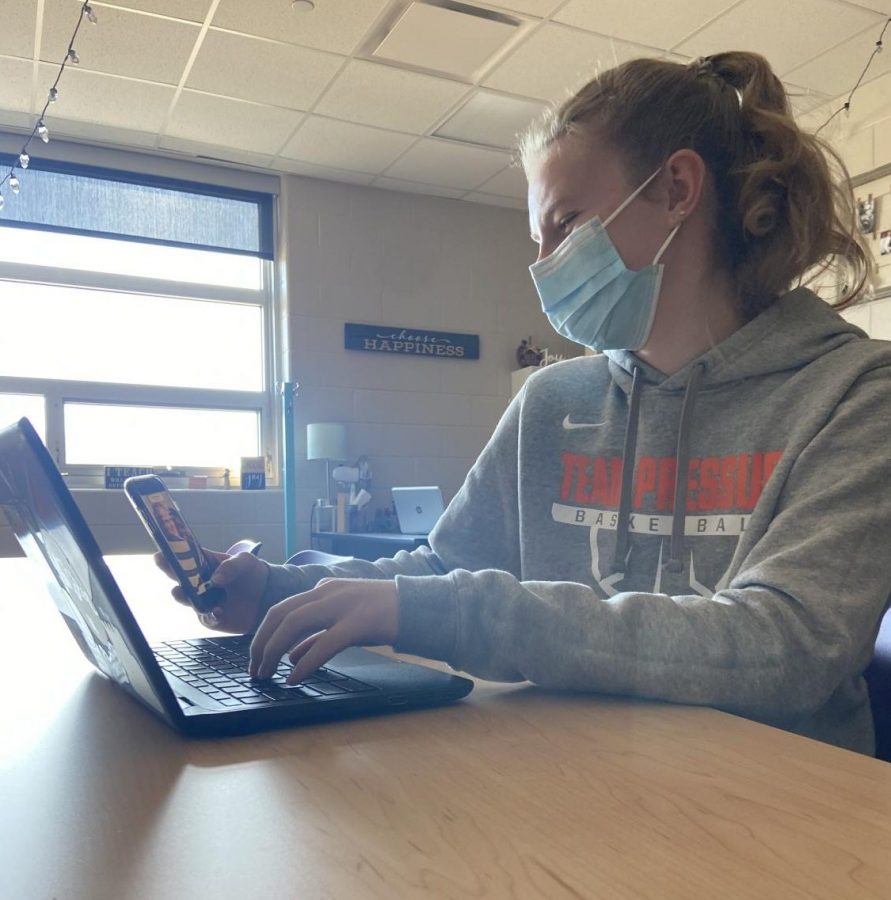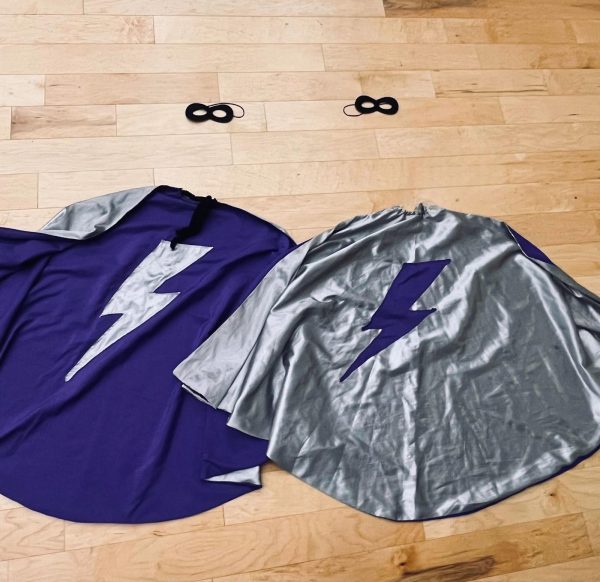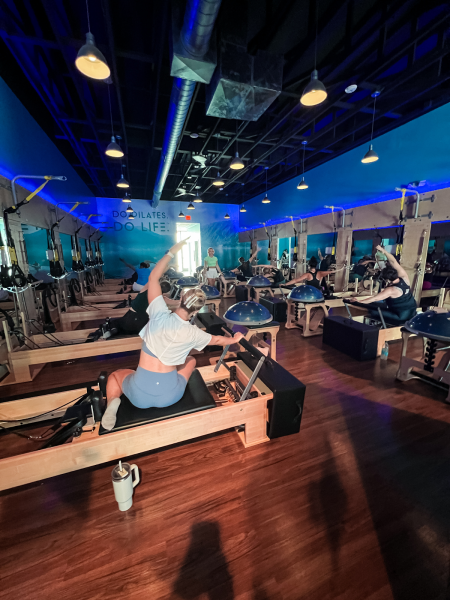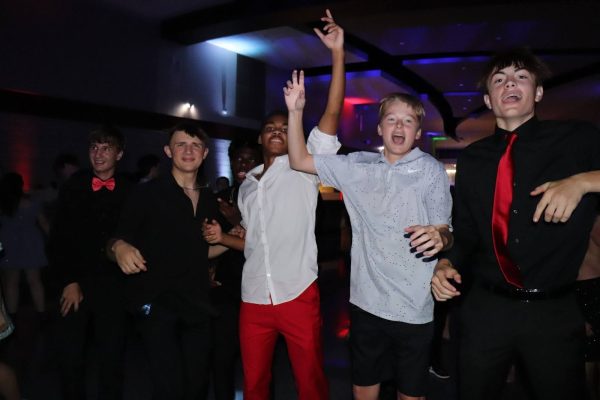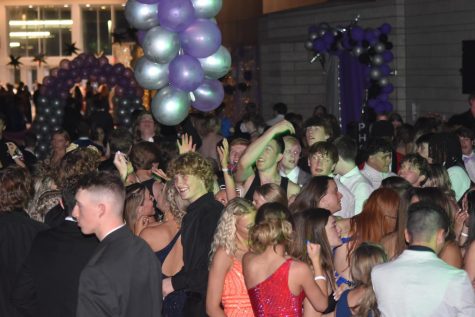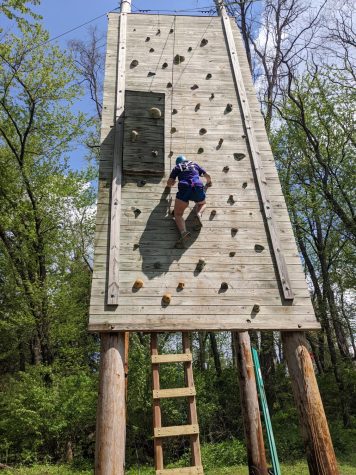Teens on Screens
As online students continue to do school entirely on one screen, hybrid students are in the classroom, omitting the need for constant computer time.
Laney Prelle, sophomore, works on schoolwork and social media at the same time.
In 2015, the average teenager spent around 7 hours a day on a screen. Now, the world has become virtual, and screens are requiring even more of teens’ time.
From September to February, Liberty students have either been enrolled in the hybrid model, online model, or a mix of both. Online students do the entirety of their school work on a screen. They are taught through Zoom calls and then go on to do their assignments online. While hybrid students have been taught in person, the majority of asynchronous assignments are online.
Cathy Cooper, senior, has been enrolled in the ICCSD PK-12 online model the entire academic year. While this year has been difficult for an abundance of reasons, the excess screen time has been an additional obstacle.
“I definitely spend more time on screens than I have in the past because as an online student all of my homework is posted on Canvas, whereas in past years many of my homework assignments were worksheets that I was given a physical copy of. Last year I used my Chromebook so little that I only had to charge it once or twice per week, but this year I use it so constantly that I have to charge it every single day,” said Cooper.
Each school day, Cooper spends 5-7 hours on a screen for academic purposes.
Santiago Fajardo-Cassab has been enrolled in the hybrid program all year. Even though he hasn’t been a part of the online program, he agrees that this school year is screen-heavy.
“For academic purposes, I have definitely spent much more time on screens. From Zooms when we were full online to now when most assignments are online in Canvas, I’d say I have spent a few hours extra on-screen time due to school,” said Fajardo-Cassab.
Ava Warkentin, junior, has been enrolled in both the hybrid and online models this year.
When comparing the two, Warkentin said that the screen time required in the online model is higher than that of the hybrid model, but the amount of time spent on screens unrelated to school makes up for that time.
“Online [school] required more because of Zoom. It required about 4 hours, depending on the day… In hybrid, I spent more time on a screen not school-related. I spent about 2 more hours,” said Warkentin.
During asynchronous time, there is no structure set by the school for either online students or hybrid students. However, the amount of structure differs between the two models.
“I felt like the screen time in online [school] was a lot more consistent and easier to adapt to compared to [the] Hybrid [model],” said Warkentin.
This unstructured learning time makes it easier for students to spend time on screens unrelated to academics.
“In my free time, I spend about 7-8 hours on a screen,” said Warkentin.
Between synchronous and asynchronous days, Fajardo-Cassab spends more time on a screen during asynchronous time.
“I spent more time on screens during asynchronous days due to the majority of the work being on canvas rather than on paper. I’d say it was about an hour extra each asynchronous day,” said Fajardo-Cassab.
The extra screen time this year has had varying effects on students, both physically and mentally.
Some effects include eye strain, fatigue, lack of sleep, impaired social skills, weak emotional judgment, low self-esteem, and delayed learning, especially in younger people.
Fajardo-Cassab has experienced more negative effects from the excess screen time.
“Ever since we made this transition into a more screen-focused school I have definitely experienced more headaches than I used to, I used to get none but they definitely are more frequent now when we were in hybrid and online,” said Fajardo-Cassab.
For Warkentin, screen-based school has been a positive thing.
“The amount of screen time in online [school] kept me more motivated, ” said Warkentin.
While this year has required more screen time from students, it has also allowed additional opportunities that full-time school does not.
“A huge perk of online school is that the flexibility in my schedule from the asynchronous time has allowed me to put in extra hours at my job. Going to work is a nice break from Zoom classes and assignments, and it makes a huge difference in my mental health,” said Cooper.
Since the pandemic began, Cooper has turned to social media for social opportunities she wouldn’t otherwise have.
“My social media use has definitely increased to help fulfill my social needs. Though social media usage is often perceived as a negative thing, I think it has really helped me to feel more connected to my friends and classmates during the pandemic, and ultimately I think that that is a good thing,” said Cooper.

Amelia Cleary, junior, is a first year staff member. Outside of school, Amelia spends most of her time dancing at Nolte Academy. She also enjoys hiking,...



